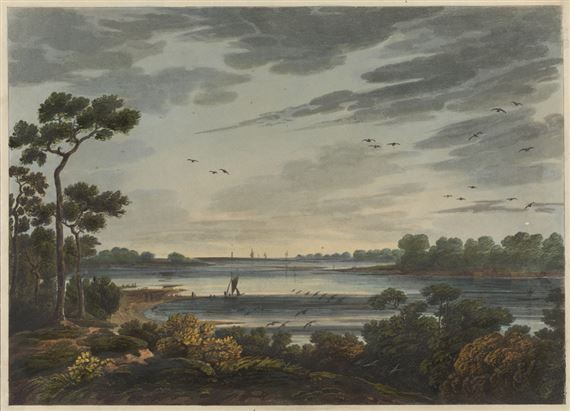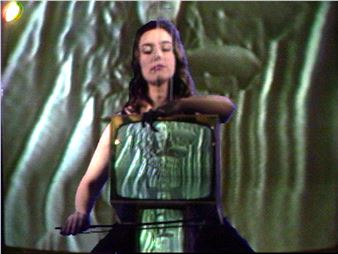Waterscape: Picturesque Views of Hampton Roads
In December 1819, English-born artist Joshua Shaw arrived in Norfolk, Virginia, where he hoped to secure subscriptions to a novel artistic ventureвҖ”a series of prints depicting scenic views of AmericaвҖҷs most pleasing and iconic landscapes. Timed to coincide with the 200th anniversary of ShawвҖҷs fortuitous visit to Norfolk, The Chrysler Museum of Art, in collaboration with Old Dominion University, is presenting an exhibition that explores the legacy of the Hampton Roads waterfront as a locus of artistic expression, economic activity, and ecological consequence. The exhibition pairs examples of ShawвҖҷs prints set around Hampton Roads with the work of Virginia photographer Scott Jost, who has interpreted similar landscapes through a twenty-first-century lens.
ShawвҖҷs presence in Norfolk was noted by the prolific diarist, dramatist, and artist William Dunlap, who rudely pronounced Shaw вҖңan ignorant, conceited English blockhead.вҖқ Nevertheless, ShawвҖҷs portfolio, Picturesque Views of American Scenery, became one of the most important achievements in early American printing and landscape art. ShawвҖҷs collection of twenty prints included three views of the waterscape around Norfolk and Hampton Roads: Lynnhaven Bay; Norfolk from Gosport, Virginia; and Oyster Cove. The emphasis on landscapes and sites close to the water reflected the waterborne route that Shaw would have taken from his base in Philadelphia as he traveled on sketching excursions. That Hampton Roads waterscapes should figure so prominently in the portfolio can be attributed to the regionвҖҷs rich natural beauty, its important position as a maritime commercial center, and its burgeoning status as a hub for artistic exchange and patronage.
JostвҖҷs large-format photographs present panoramic views of the waterfront around Hampton Roads. Unlike a single photograph that preserves one moment in time, Jost creates his landscapes through multiple exposures spread across a range of time, highlighting the fleeting effects of life at the shoreline. The juxtaposition of JostвҖҷs photographs and ShawвҖҷs prints explores the nature, appearance, and deeper implications of the rapid changes that have overtaken the waterfront landscape while also reinforcing the historical continuity of the waterвҖҷs edge as the focus of art and life within Hampton Roads.

Recommended for you
In December 1819, English-born artist Joshua Shaw arrived in Norfolk, Virginia, where he hoped to secure subscriptions to a novel artistic ventureвҖ”a series of prints depicting scenic views of AmericaвҖҷs most pleasing and iconic landscapes. Timed to coincide with the 200th anniversary of ShawвҖҷs fortuitous visit to Norfolk, The Chrysler Museum of Art, in collaboration with Old Dominion University, is presenting an exhibition that explores the legacy of the Hampton Roads waterfront as a locus of artistic expression, economic activity, and ecological consequence. The exhibition pairs examples of ShawвҖҷs prints set around Hampton Roads with the work of Virginia photographer Scott Jost, who has interpreted similar landscapes through a twenty-first-century lens.
ShawвҖҷs presence in Norfolk was noted by the prolific diarist, dramatist, and artist William Dunlap, who rudely pronounced Shaw вҖңan ignorant, conceited English blockhead.вҖқ Nevertheless, ShawвҖҷs portfolio, Picturesque Views of American Scenery, became one of the most important achievements in early American printing and landscape art. ShawвҖҷs collection of twenty prints included three views of the waterscape around Norfolk and Hampton Roads: Lynnhaven Bay; Norfolk from Gosport, Virginia; and Oyster Cove. The emphasis on landscapes and sites close to the water reflected the waterborne route that Shaw would have taken from his base in Philadelphia as he traveled on sketching excursions. That Hampton Roads waterscapes should figure so prominently in the portfolio can be attributed to the regionвҖҷs rich natural beauty, its important position as a maritime commercial center, and its burgeoning status as a hub for artistic exchange and patronage.
JostвҖҷs large-format photographs present panoramic views of the waterfront around Hampton Roads. Unlike a single photograph that preserves one moment in time, Jost creates his landscapes through multiple exposures spread across a range of time, highlighting the fleeting effects of life at the shoreline. The juxtaposition of JostвҖҷs photographs and ShawвҖҷs prints explores the nature, appearance, and deeper implications of the rapid changes that have overtaken the waterfront landscape while also reinforcing the historical continuity of the waterвҖҷs edge as the focus of art and life within Hampton Roads.
Artists on show
Contact details


 ARTISTS
ARTISTS











